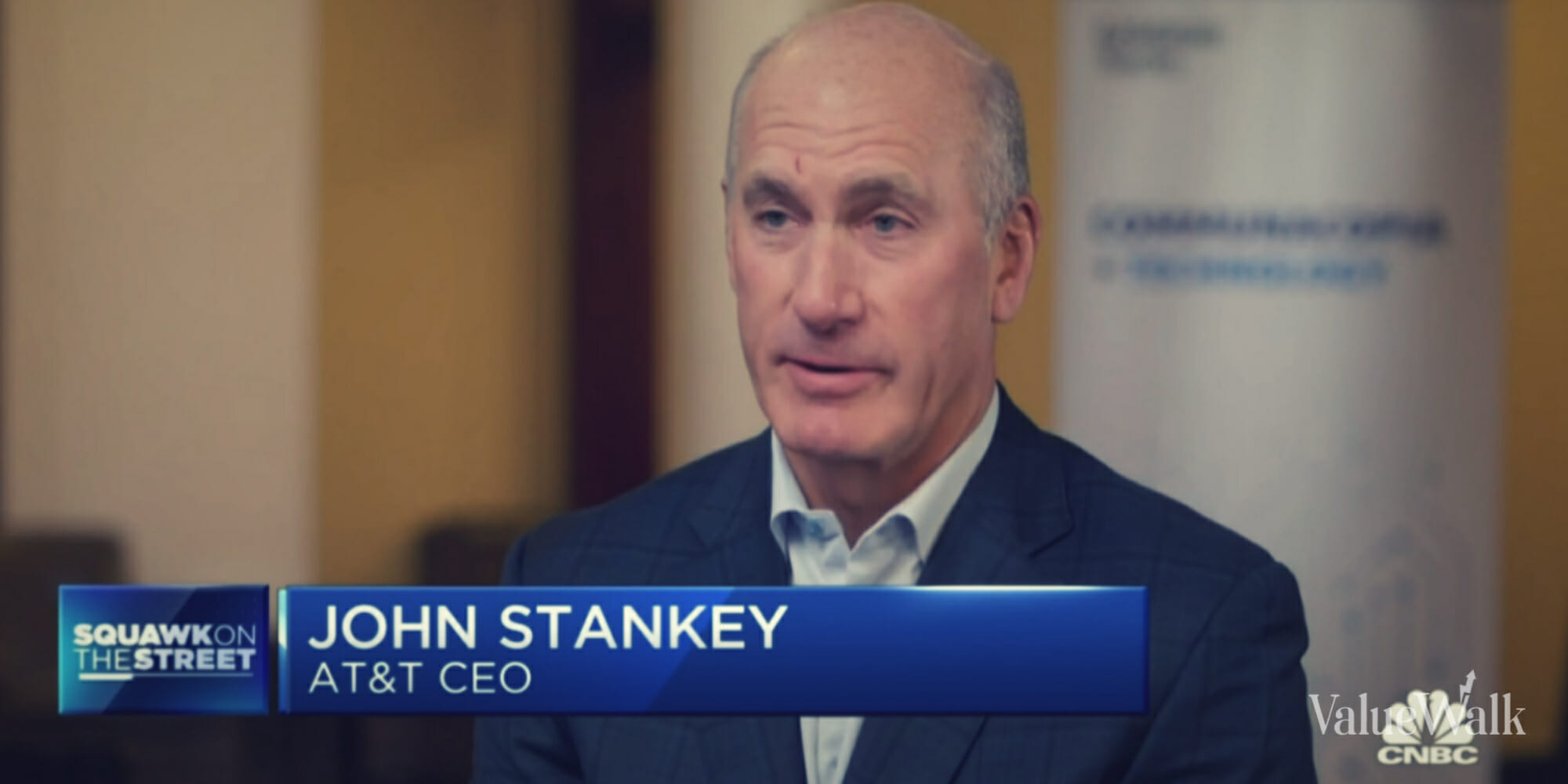Following is the unofficial transcript of a CNBC interview with AT&T Inc. (NYSE:T) CEO John Stankey on CNBC’s “Squawk on the Street” (M-F, 9AM-12PM ET) today, Wednesday, September 6 from the GS Communacopia + Technology Conference in San Francisco.
AT&T’s Price Increases Bring Value To Customers Through Free Added Benefits, Says AT&T CEO
DAVID FABER: We’re live from the Goldman Sachs Communacopia conference right here in San Francisco. Monitoring the headlines, bringing you interviews all morning as well from some of the top executives, including of course John Stankey who runs AT&T. John, it is good to see you. It’s been a while.
JOHN STANKEY: Hi David, good to see you.
FABER: Since we’ve been in person at least. Want to get right into the business, a few weeks ago, one of your key competitors T-Mobile laid off a lot of people and said what it takes to attract and retain customers is materially more expensive than it was just a few quarters ago. Are you finding that at AT&T? You know, and if so, with a new expensive, more expensive iPhone company coming you have to sort of wonder how that’s gonna play out as well.
STANKEY: Look, we’ve been pretty stable on all the things we’ve been doing to attract customers. I can’t speak to their circumstances or what they’re having to do to grow their customer base. But in our situation, we’ve had a very consistent go to market strategy, we’ve been doing it for several years. We haven’t really backed off of it. In fact, I think we’ve gotten better at it and we see on the margin, it’s become a little less expensive for us to bring customers in and we’ve been pretty diligent about making sure we bring in the right kind of profitable customers so I can’t say that that’s necessarily a dynamic that we’re seeing within our business right now.
FABER: — that it’s getting more expensive for them but you’re seeing it sort of—
STANKEY: Yes, I can’t, I don’t know his business and I don’t know exactly what they’re experiencing but in the approach we’re using across the various distribution channels we built, we’re not having that issue.
FABER: What are your expectations for the new iPhone?
STANKEY: I would expect that like any release, it’s going to have a little bit of an uptick that occurs during that period of time. Traditionally, what we see seasonally is it slows down the month or so before release. It comes out, there’s a bit of a spike. I think the phone will obviously be attractive and do well. But generally speaking, the devices are getting a bit more expensive and I think consumers are being a little bit more guarded and how frequently that they’re upgrading. So I think it’ll do well. I don’t have any reason to expect that that’s the case but I think consumers right now will be a little bit selective if they can defer ultimately replacing the device.
FABER: You talk about, the length, you know, the product cycle. So do you expect that to continue, you don’t think this new phone is going to have the impact of perhaps reverting that or bringing it back a bit.
STANKEY: I don’t think so. I think what happens and we’ve seen this not just in phones but if you go back to the laptop dynamic, etc., anytime price goes up on something that it tends to suppress demand a little bit. The prices have generally been going up on devices, therefore I don’t think it’s going to necessarily reverse the demand cycle.
FABER: You’ve been bringing prices up a bit as well effectively increasing and how sustainable do you think that is?
STANKEY: Well, look, we’ve been investing an incredible amount in the business as, as the industry has. I mean, just in the three years I’ve been in this job, we’ve done $100 billion of capital investment and spectrum investment. And ultimately when you make that kind of investment, your asset base you have to recover and return and customers have been using the product extensively more.
We see growth and data driving up almost 40% a year. And so as a result of that, there does have to be some recovery in that that comes in pricing in some regard. We’ve been doing it in a way that drives great value back into the customer. So while we’ve been able to drive our ARPUs up, our churn has remained relatively stable and we’ve been giving the customer more value for what they’re paying us, more data, more freebies that come along with the service that they use like hotspot data and capabilities and a lot of other things that we’ve been doing to try to make sure that as the customer is paying us a little more, they walk away feeling good about that.
FABER: That said, you know, I, doesn’t go without notice that I think half the I think it’s something like half the subs right now are being new subs are being captured by cable and their pricing obviously a lot lower than you are. Is that a competitive threat that ultimately will mitigate your ability to continue to raise price?
STANKEY: I think frankly, if you look at where cable is playing right now, they’re playing in a particular segment of the market. Many of our customers are actually part of family plans or their multi line accounts. We haven’t seen that kind of incursion coming from cable. We’re, we’ve been very good as you see our churn numbers have been really attractive.
We’ve got great combination going of increasing ARPU, low churn, improving customer satisfaction. So I do believe cable will have a certain place that they play in the market but ultimately over time when demand continues to rise at the level it is and the customer uses 30%, 40% more data a year and if you’re on a variable cost structure for your product, which cable is, that’s a hard place to be a low price leader because you know your input costs are going up just as the consumption goes up.
FABER: So you believe at some point this is going to moderate in terms of the growth that cable is seeing in wireless subs or the quality of those subs will actually continue to decline.
STANKEY: Our strategy at AT&T has been really clear and we think we’re in a unique position. We believe that you ultimately need to own and operate both fixed and wireless networks to do what the customer wants to do which is get on the internet any place and anywhere. And so when we own and operate those networks and we can control our cost of service, that gives us an opportunity in the market to get the best customers and the most profitable customers and that’s the long term strategy we’re playing right now.
FABER: Right. You are, you are also actually playing in what has typically been cable’s area which is by over building fiber in a lot of areas of the country. Why is that a viable strategy at this point? You’ve devoted a great deal of capital to it and are you seeing the return that you’d expect?
STANKEY: Yeah, I wouldn’t call it a cable’s area. I mean, we’ve been in the broadband business for many years. And I think the difference is now that we are in the broadband business with a superior product.
FABER: You have, I mean of course, take me back to see Michael Armstrong days.
STANKEY: Yeah, so, you know, we’re now in the business with a superior product and it’s a successful and a smart investment because demand in the household continues to increase dramatically and we don’t expect that change. Customers get a lot of value out of their fixed broadband service and fiber is one of the best ways to deal with that.
And more importantly, we’re starting to see patterns change in the household where not only is there a lot of consumption coming into the house but consumers are sending a lot of data back up to the network as user generated content starts to occur, as we start to see things like VR and AR come on the advent. And with that, fiber is the best technology in order to have that symmetrical bandwidth up and down.
FABER: Right—
STANKEY: We think it’s going to be really smart.
FABER: Wireless where Verizon and T-Mobile seem to have been more aggressive, particularly T-Mobile. You guys have not. Is that because of what you’re describing?
STANKEY: Yeah. Ultimately, we think the demand equation outstrips the ability of a wireless network to effectively serve that capacity at an affordable cost. There’s a period right now where there’s some fallow capacity in the industry and people are putting it to work with fixed wireless access. And there’s certainly certain customers that that’ll be a great technology to support their needs. But for most households, we ultimately believe that the fixed broadband connections into the home are going to be critical.
FABER: What’s the economy look like right now? You usually have a decent view of it particularly in the enterprise in terms of even people coming back to the office, for example, what are you seeing?
STANKEY: It’s resilient, probably more resilient than most would have given it credit for. I don’t see anything in our customer base that suggests to me that anything has changed.
FABER: Any delinquency changes at all?
STANKEY: No, nothing that, you know, our customers are still paying their bills and they’re still buying. Certainly, I watch all the indicators in the economy like anybody else, and there’s a lot of uncertainty generally speaking, you know, in the global environment when one of those things triggers, look, who knows when it happens.
FABER: But you kind of said you, you’ve been running the company conservatively perhaps because you anticipated a downturn that is yet to actually come?
STANKEY: Well, we’ve been running the company in a way that we can adjust to whatever circumstances are thrown at us and I feel real comfortable that the guidance we’ve put out there and what we can do between now and the end of the year, I see no concerns and nothing there that causes me to step back and take a different posture or a different view on that. But the good thing is because we’ve managed to streamline the business and get it focused, if things change, we can adjust accordingly. We’ve got a lot of different levers we can pull now.
FABER: When you talk about streamlining the business, what do you mean?
STANKEY: Our business is focused on connectivity now? It’s focused on—
FABER: Oh yeah, you don’t own those cable networks anymore. Do you?
STANKEY: No, we don’t.
FABER: You must be happy about that by the way, I don’t know if—
STANKEY: I’m happy about—
FABER: This Disney Charter thing.
STANKEY: I’m happy about being in business where customers need more of the product every day and they’re using more of it every day and they take a lot of value out of the service.
FABER: You know on the call specific to sort of your new focus, you said and this was a quote I just wanted to try and understand it better. “We know that channels in the consumer market that we can go to to intercept the right kind of traffic.” What does that mean?
STANKEY: Well, one of the things that we’ve managed to do to kind of reverse our growth vector and I think it’s really important to understand when you look at our share of non-equipment revenue, the revenues that we build every month in our wireless business, over the three year period I’ve been in the job, we’re actually growing our share of industry revenues faster than T-Mobile is.
So while we may not be adding the same number of customers and we’re not selling fixed wireless service, we are getting very good yields off the customers that we’re bringing in, over 8 million postpaid subscribers in that three year period. We’ve done it by tuning the right distribution channel to where we can get the right customers. So, for example, in FirstNet, where we have the ability to go after public safety where we are under penetrated. You know we have an example of that right here.
FABER: You brought your props, going to get to them.
STANKEY: Back from Maui, you know, cell site in the box right there that we’re able to—
FABER: Right, what does this actually allow for?
STANKEY: This allows us to make sure that for first responders and we’re able to put capabilities in place whenever there’s a disaster and we have a nice service layer of employees that help out, go out on site, make sure that after a hurricane, a fire or anything, the communication is in place for those really important jobs.
FABER: It’s great from a public service perspective. Does it make money too?
STANKEY: Yeah, it absolutely does. We’ve added over 5 million devices since we’ve gone into the FirstNet business, which is a place we weren’t selling successfully. And so getting the right distribution channels in the right segments where we were under penetrated has been a key driver behind that. And it’s what’s allowed us to attract the profitable growth and the customers that we really want to get.
FABER: In the brief time we have left, lead cables that came up and crushed the stock price for a while. Very, you know, some questioning of the Wall Street Journal’s reporting around the actual environmental concern or how significant it should be. Are you prepared to say anything more than what you’ve said in terms of where you think the state of play is here what the threat is to the company?
STANKEY: Well, I’ll reemphasize what we’ve said, which is, you know, first of all, when somebody makes an allegation like what the Wall Street Journal did about public safety, we take it very seriously. And we want to make sure our employees are safe and we want to make sure that communities we operate in are safe.
And I was pretty clear with our employee body and I think I’ve said externally that we felt like the Wall Street Journal had over driven their headlines in characterizing a public safety and public health crisis. Since that time, there’s been quite a bit of public information that’s come back. We’ve had the state of New York that’s tested sites and declared that there’s no public safety problem in those sites at the Wall Street Journal—
FABER: And those were site that were actually cited in the article?
STANKEY: Yesterday, the EPA did the same on another site that was indicated in the article. We’ve had two locations Lake Tahoe, including others in Michigan, that we’ve produced data back to the EPA that says there’s no public safety crisis facing in America right now.
So we believe that we have followed the laws. We’ve done all the things that our regulators have expected us to do to operate our business effectively, to keep our employees safe. We’ll continue to look for any indications if there’s new science or something that we missed or that the regulator’s miss that we need to respond to but thus far in working with those individuals who are experts, we’ve come away feeling very strong—
FABER: So you don’t feel like there’s got to be an enormous allocation for a mediation from the company.
STANKEY: We’re listening to everything and right now we feel pretty good about the position we’re in as we did before that article was printed.
FABER: John, given everything you’ve just discussed and you and I’ve sat down for interviews for a number of years here, including before he took the top job, what do you say to AT&T shareholders at this point in terms of what they should expect? Because when I go back and we can show a chart here, it’s been paying. I mean, you know that, they know that. There’s been a dividend, but what do you tell them in terms of why they should hang on why, they should believe the strategy is going to actually result in a stock price that goes higher?
STANKEY: Ultimately, that’s the test of any CEO, right, is do you create value for the shareholder and I think everybody on the management team at AT&T understands that. I feel really good about what we’ve done over the last three years, David. We’ve refocused the business.
The operating results, as you saw last quarter, are really solid and the team has done a remarkable job in putting the business in a better position. Now I’m also responsible for balancing that short term return versus long term return and to the point I made earlier, we’re investing a lot of money in this business to build a sustainable company that generates returns for shareholders for a long time. We’re in the early innings of that happening. I think you’re starting to see the green shoots of—
FABER: What do you think it’s going to take for the market to recognize that? Is it just simply going to be a longer period of time where you’re where you are delivering on, for example, the free cash flow goals that you’ve set out?
STANKEY: When the cash consistently shows up, eventually the market will recognize it and then we remove some distractions like what you just mentioned which is uncertainty that’s created by something like lead that certainly doesn’t help valuations over the long term and I’m confident we’ll work through that and the market will be able to assess that but its bottom line, saying what we’re going to do, delivering the cash. I think you’re seeing that trend start to establish itself.
FABER: And at what point do I sit here with you and hold you accountable if in fact that’s not the case? Or even if it is, how many years?
STANKEY: That’s up for the board to decide, not you and—
FABER: Wait, I don’t get to decide that?
STANKEY: I’m accountable every day.
FABER: I meant accountable, not as in firing you John, but just simply asking you and saying have you succeeded or failed?
STANKEY: Well, you’re doing it right now. You know, obviously, every day when I wake up, it’s the first thing I think about and we know when we understand that we have to take the capital that we’re given and invested and earn a return on it. I think we’re on the right path to do that.












